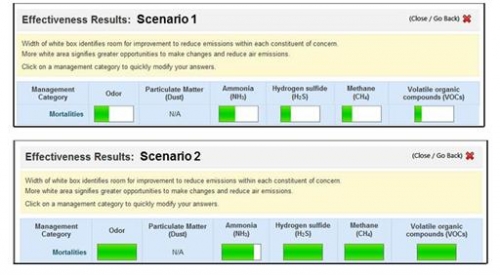Managing livestock odors
Animal housing, manure storages and land application make significant contributions to on farm odors, but when addressing total farm odor livestock farm managers need to consider feed storage and mortality management.
While most farm odors are associated with animal housing, manure storage and land application. There are other management categories on livestock farms, and while their contribution to total farm odor may seem small, addressing these areas may yield small reduction in overall farm odor and large benefits in improved perception by non-farm neighbors. With summer just around the corner, a time of increased outdoor activity by all rural residents and a period of increased awareness of livestock farm odors, now is an opportune time for livestock farm managers to do a quick assessment of these less conspicuous odor sources.
Stored feeds
Stored feeds can be of little concern or can be a large contributor to total farm odor. Dry feeds kept covered and out of the weather and silages kept tightly covered will generate very little additional odor. When exposed to moisture, dry feeds undergo biological processes similar to stacked manure resulting in unnecessary odors. When exposed to weather, fermented feeds lose quality and give off odors. Uncovered or poorly covered silage piles and poor quality feed stacked off to the side of the bunker are easily prevented sources of odor on the farm. Not only does spoiled feed add to the total farm odor it represents a waste of valuable farm resources.
Mortality handling
Animal mortality is a normal livestock farm event. How mortalities are handled impacts overall farm odor. Mortalities that are picked up, buried, or otherwise processed within 24 hours present a very small odor potential. However, if left to linger they can be a significant source of offensive odors.
One option for mortality handling is on farm composting. Composting is an environmentally safe process for disposing of livestock mortality that is being used on an increasing number of livestock farms. When properly managed using acceptable guidelines there is very little odor associated with the compost process. But if the compost facility is undersized or poorly managed what should be a small source of concern becomes both an unpleasant and an easily recognized source of odor. For more information on composting and other mortality handling methods see “Disposal of Dead Animals in Michigan”.
Public perception
While the old axiom “people smell with their eyes” might be a stretch of true human capabilities there is some truth to the saying. Neighbors are less likely to be annoyed by well-kept facilities and a landscaped farm site. Landscaping tends to draw one’s vision away from animal facilities and towards the more appealing landscaped area. Neighbors will also be more tolerant of normal farm traffic if roads are neat and clean but may be really annoyed by spilled manure and dirt tracked on to the road as equipment moves in and out of the farm.
Evaluating odor on your farm
The National Air Quality Site Assessment Tool (NAQSAT) is an online tool available for evaluating air emissions, including odor, from livestock operations. NAQSAT evaluates emissions from eight farm management categories, including feed and water, mortalities and public perception. The results pages from the same sample farm are provided below that illustrate the impact of managing mortalities under two different scenarios. In Scenario 1 the green area indicates the effectiveness of the farm’s previous practices and the white area indicates the opportunity for improvement. After reviewing the results from Scenario 1 the farmer recognized the obvious opportunity for improvement. He reviewed the aforementioned “Disposal of Dead Animals in Michigan” and the “Michigan Animal Tissue Compost Operation Standard”. The “Spartan Animal Tissue Composting Planner”, a spreadsheet for sizing mortality compost units, was used to recalibrate the facility size requirements for the number of livestock housed on the farm. Finally, one employee was assigned and trained for the task of daily mortality and compost management. The improved management of the compost facility is evident in the Effectiveness Results for Scenario 2 with the increased area of green filling the bar under odor along with the increased green in the bars under the other emissions of concern.
The National Air Quality Site Assessment Tool is available for dairy, beef, swine, turkey, broiler and layer farms. A user’s manual and instructional video are both available on the home page.
Animal housing and manure storage are significant odor contributors on livestock farms. Improved practices in other management categories may help reduce overall farm odor and rural residents’ perception of the farm operation. Tools such as NAQSAT help evaluate odor emissions and provide the option of examining improved management practices for reducing odor and other emissions.



 Print
Print Email
Email


